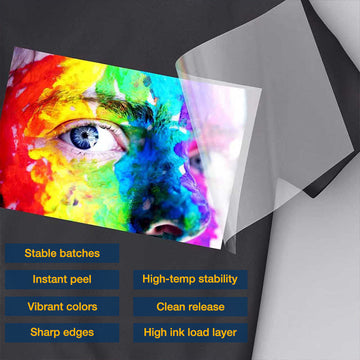TL;DR
Color accuracy = RIP/ICC setup + white ink underbase + powder & curing + press settings + stable environment.
Do linearization → ink limit → ICC, then fine-tune white density + choke and always post-press.
1) The 5 Biggest Drivers of Color
-
RIP / ICC profiles – control gamut, neutrals, and skin tones.
-
White underbase – opacity and choke (0.1–0.3 mm) affect edge cleanliness and bleed.
-
Ink load & drying – too much = muddy; too little = washed-out.
-
Powder & curing – particle and flow change saturation and L*.
-
Heat press – temp/time/pressure shift hue and contrast (overheat can yellow whites).
2) The 7-Step Color Workflow (Do This First)
-
Calibrate your monitor (D65, ~120 cd/m²; neutral room light).
-
Select the right media preset in the RIP (film + ink + printhead).
-
Linearize CMYK with a printed gray ramp.
-
Set ink limit at the highest point before oversaturation/sticky powder.
-
Apply a proper ICC (vendor ICC if available; otherwise build with a spectro).
-
Tune white ink density (+5–15% on darks) and add choke 0.1–0.3 mm.
-
Post-press 5–10 s after peel; verify skin tones, blacks, and edges.
3) Ready-to-Use Recipes (Copy → Test → Scale)
-
Black Cotton Tee (high saturation)
White +10% • Choke 0.2 mm • Press 160 °C / 12–15 s medium-firm • Post-press 8 s -
Red Poly Sportswear (anti-migration)
Press 150–155 °C / 15–20 s medium • Use low-temp + longer time + barrier sheet -
Detail Art (linework/micro text)
Fine powder • Ink −5–10% • Choke 0.1 mm • Post-press 6–8 s
4) Fast Troubleshooting (At-a-Glance)
| Symptom | Likely Cause | Fix Now |
|---|---|---|
| Looks gray, low contrast | Ink limit too low; no post-press | Raise ink limit; post-press 5–10 s |
| Skin tones too red/yellow | Wrong ICC; overheating | Use correct ICC; drop 3–5 °C or shorten 2–3 s |
| Blacks look brown | White too heavy; over-curing | Reduce white 5–10%; lower cure temp/time |
| Edge bleed/halo | No choke; powder too coarse | Add 0.2 mm choke; switch to finer powder |
| Grainy color blocks | Under-cured powder; air too dry | +5 °C or longer cure; humidity 45–55% RH |
| Reds/fluos off-gamut | Gamut limit/ICC mismatch | De-saturate design or use a wider-gamut ICC |
5) Press & Powder Settings That Protect Color
-
Curing (on powder layer): 110–130 °C, 2–5 min, until uniformly translucent (not sandy).
-
Press (cotton/blends): 155–165 °C, 10–15 s, medium-firm.
-
Press (poly/stretch): 150–160 °C, 12–20 s, medium.
-
Peel: follow film type (hot/warm/cold).
-
Post-press: 5–10 s with protective sheet → boosts wash fastness and perceived contrast.
6) Environment = Consistency
-
Keep 45–55% RH to reduce static (color mottle) and powder clumping.
-
Standardize room lighting (no warm/yellow cast).
-
Schedule nozzle checks and white-ink circulation daily.
7) QC Checklist Before You Ship
-
Neutral gray ramp looks neutral (no color cast).
-
Brand colors within acceptable ΔE.
-
Edges clean with choke; no bleed.
-
Wash test (40 °C, 5–10 cycles): no peeling, minimal shift.
-
Rub fastness (dry/wet) passes your spec.
Pro Tips
-
Soft hand + saturation: slightly lower ink, finer powder, strong post-press.
-
Dark tees: +white density, but guard against over-curing (yellowing).
-
Polyester: go lower temp / longer time to avoid dye migration.
Why KungFuDTF?
We supply calibrated films, inks, and TPU powders that play nicely together—plus ICC guidance and starter recipes—so your screen color matches the shirt, not “almost”.







